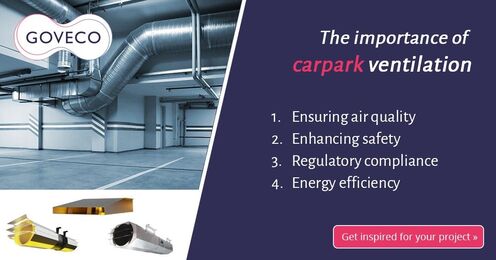Blog
Download our brochure

Stay informed

The Importance Of Carpark Ventilation
Effective carpark ventilation is essential to ensuring the safety and comfort of both drivers and pedestrians. As enclosed spaces, carparks are prone to accumulating harmful gases like carbon monoxide (CO) and nitrogen dioxide (NO2) from vehicle exhausts. Proper ventilation systems are vital to maintaining air quality, preventing the buildup of hazardous substances, and complying with safety regulations. This article explores the importance of carpark ventilation, the different technologies available, and the advantages of utilizing high-performance solutions like axial and centrifugal jet fans, such as those offered by Goveco.
Effective carpark ventilation is essential to ensuring the safety and comfort of both drivers and pedestrians. As enclosed spaces, carparks are prone to accumulating harmful gases like carbon monoxide (CO) and nitrogen dioxide (NO2) from vehicle exhausts. Proper ventilation systems are vital to maintaining air quality, preventing the buildup of hazardous substances, and complying with safety regulations. This article explores the importance of carpark ventilation, the different technologies available, and the advantages of utilizing high-performance solutions like axial and centrifugal jet fans, such as those offered by Goveco.

Understanding Volume Control Dampers in the HVAC Sector
In the realm of Heating, Ventilation, and Air Conditioning (HVAC), ensuring the comfort and safety of indoor environments is paramount. An essential component that plays a pivotal role in the HVAC systems' effectiveness is the Volume Control Damper (VCD). These devices are integral to managing and regulating airflow within duct systems, ensuring that air distribution is both efficient and precisely controlled.
In the realm of Heating, Ventilation, and Air Conditioning (HVAC), ensuring the comfort and safety of indoor environments is paramount. An essential component that plays a pivotal role in the HVAC systems' effectiveness is the Volume Control Damper (VCD). These devices are integral to managing and regulating airflow within duct systems, ensuring that air distribution is both efficient and precisely controlled.

Alizé CO2 - New product of the Alizé range from Anjos
The ALIZE CO2 is the newest product of the ALIZE range from Anjos, consisting of exhaust valves able to self - adjust their opening and thus the airflow.
The ALIZE CO2 is the newest product of the ALIZE range from Anjos, consisting of exhaust valves able to self - adjust their opening and thus the airflow.

High quality circular and rectangular VAVs
VAV systems are considered more complex systems but when implemented correctly offer a more cost-effective solution when compared to CAV systems. The proper functioning of a VAV system depends on the performance of the VAV dampers.
VAV systems are considered more complex systems but when implemented correctly offer a more cost-effective solution when compared to CAV systems. The proper functioning of a VAV system depends on the performance of the VAV dampers.

What is a centralized air conditioning system?
The main aim of a Heating, Ventilation and Air Conditioning (HVAC) system is to achieve and maintain the desired indoor environment condition at the minimum possible energy consumption. For big centralized systems, it is of great importance that the proper design strategy is selected. The two main air system types found in centralized HVAC systems are Constant Air Volume (CAV) and Variable Air Volume (VAV) systems. This article aims to present the main features of the two types of systems, their advantages and disadvantages and what is the selection process between the two at the design stage of an HVAC system.
The main aim of a Heating, Ventilation and Air Conditioning (HVAC) system is to achieve and maintain the desired indoor environment condition at the minimum possible energy consumption. For big centralized systems, it is of great importance that the proper design strategy is selected. The two main air system types found in centralized HVAC systems are Constant Air Volume (CAV) and Variable Air Volume (VAV) systems. This article aims to present the main features of the two types of systems, their advantages and disadvantages and what is the selection process between the two at the design stage of an HVAC system.

RDR - Constant Volume flow regulator
The flow regulator RDR is an element placed inside the duct in order to obtain a constant flow within a pressure range from 50 to 250 Pascals. It is used in air conditionning or ventilation systems either in extraction or blowing mode.
The flow regulator RDR is an element placed inside the duct in order to obtain a constant flow within a pressure range from 50 to 250 Pascals. It is used in air conditionning or ventilation systems either in extraction or blowing mode.
